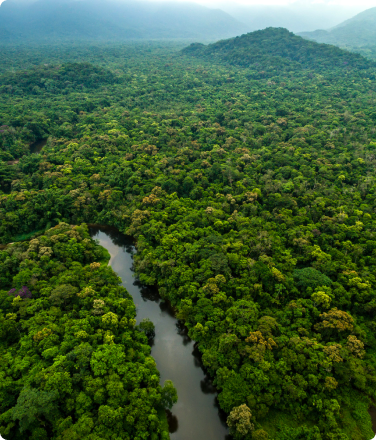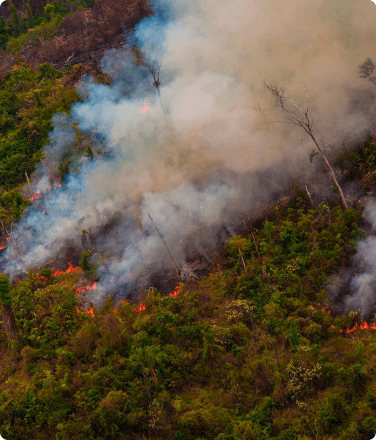Every day, decisions made by governments, banks, and investors open the door to intensified resource extraction on Indigenous peoples’ territories. And with each decision made, the Amazon, a rainforest long at the mercy of extractive industries, is pushed closer to an irreversible tipping point. So when world leaders united to debate who should decide how to protect the future of our planet, a good place to start would have been by recognizing the rights of the Indigenous communities who already safeguard the tropical forests that regulate our climate.
COP30, the 30th Conference of the Parties under the UN Framework Convention on Climate Change, just came to a close in Brazil’s Amazonian city of Belém. Indigenous delegations and community members arrived in countless numbers, some traveling by boat for weeks down the Amazon River. They made this journey to assert their participation in the summit and remind world leaders that despite representing less than 5% of the global population, Indigenous peoples and local communities safeguard more than half of the world’s remaining intact forests and nearly half of all Key Biodiversity Areas, the most richly biodiverse places on our planet.1
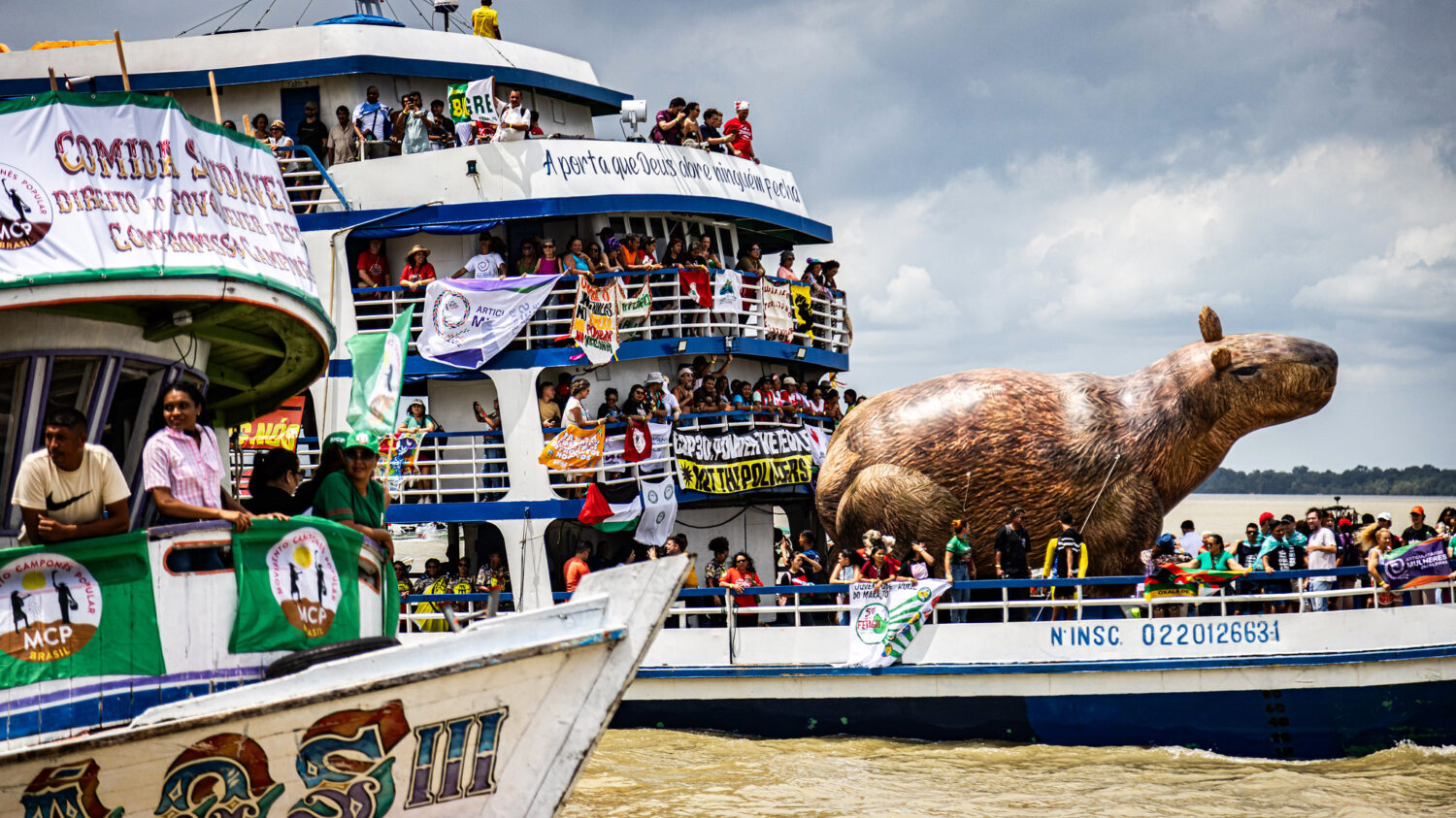
The rainforest does not exist without Indigenous peoples. Decisions about the Amazon must be made by the peoples of the Amazon.
– Leo Cerda, Kichwa land defender from Napo in the Ecuadorian Amazon
The Clock is Ticking
Scientists warn that if just 3% to 8% more of the Amazon disappears, as much as 60% could collapse into savannah. The consequences of this will reverberate across Earth triggering massive carbon releases, disrupted rainfall patterns, food scarcity, mass species extinction, and escalating humanitarian crises. Clearly, the clock is ticking. And the Indigenous peoples whose ancestral lands and livelihoods lie within these forests are owed the tools and resources they need to protect them, before the window for action closes.
Ahead of COP30, the Indigenous movement launched the campaign The Answer is Us – All of Us, amplifying a truth proven time and time again, that many solutions to the climate crisis already exist in the communities that have protected life for centuries, and we must work together to defend their rights and our shared future. The question is whether world leaders finally listened.
The Tropical Forest Forever Facility: Big Vision, Modest Commitments
At COP30, the Brazilian government unveiled the Tropical Forest Forever Facility (TFFF), a proposal to deliver steady, long-term payments to countries that can prove they are protecting their forests. The model combines about US$25 billion in public funding with US$100 billion in private investment raised through the sale of bonds. These proceeds would be reinvested in emerging-market assets, and the annual returns would reward countries that keep their forests standing, at about US$4 per hectare conserved, provided they maintain deforestation rates below 0.5%. Thanks to a co-design process led by the Brazilian government, the Ministry of Indigenous Affairs, and Rainforest Foundations US’s (RFUS) partner, the Global Alliance of Territorial Communities (GATC), at least 20% of TFFF’s payments would flow directly to Indigenous peoples and local communities through Indigenous-led institutions and community-governed mechanisms.
However, donor contributions at COP30 fell far short. While Brazil aimed for US$25 billion in government funding, nearly all the start-up money announced during the summit came from just five nations. Brazil, Norway, Indonesia, and later Germany pledged matching contributions of US$1 billion each or more, with only a handful of smaller commitments from others. Altogether, these pledges total just US$6.6 billion, far below the target needed to leverage an additional US$100 billion in private capital, a shortfall that risks undermining confidence in the fund. Notably, several major economies that had previously signaled interest, including China, Saudi Arabia, and the United Kingdom, have yet to contribute, with commitments expected next year.
The Government of Brazil has now announced a revised target to raise US$10 billion by the end of 2026, and asserts that this is sufficient sovereign capital for the TFFF to leverage US$40 billion in private investments and for the TFFF to commence operations, though at a smaller scale, with potentially smaller payouts to tropical forest countries.
For TFFF’s Indigenous and local community component to really get off the ground, investments are needed now to strengthen Indigenous- and community-led territorial funds, provide technical assistance, and build the inclusive governance structures required. We also need deeper policy dialogue between rightsholder movements and national governments to capitalize on the opportunity created by TFFF’s ‘direct access’ modality.
– Joshua Lichtenstein, Policy Director at Rainforest Foundation US, who supported the GATC throughout the TFFF co-creation process
Big Wins for Indigenous Land Rights in Brazil
“Demarcation now”, or “Demarcação já”, echoed throughout Belém as the national Indigenous movement mobilized at COP30, demanding that the Brazilian government legally recognize their ancestral territories. And this time, their voices were heard.
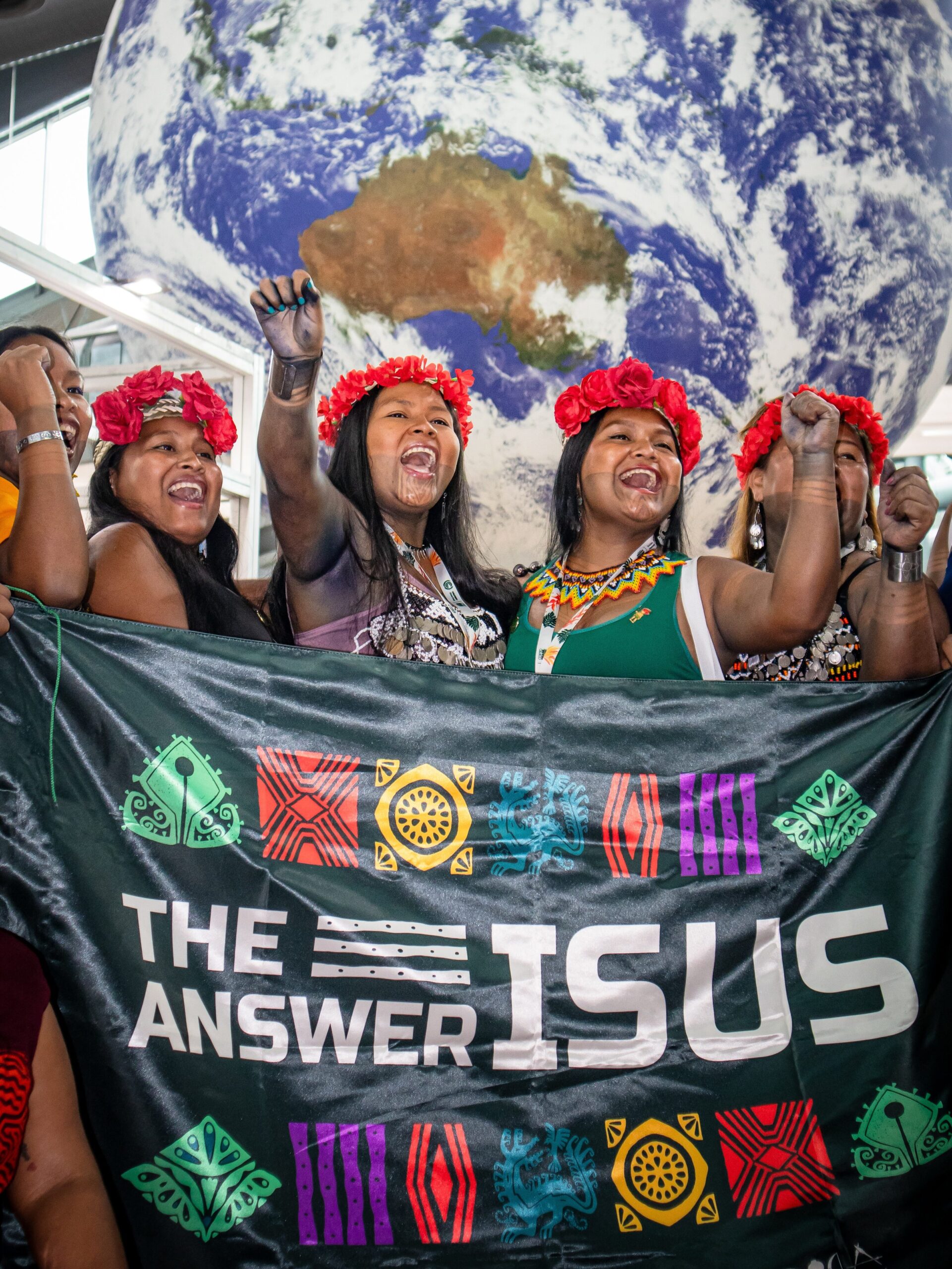
During COP30, the Brazilian government announced the first major land rights package in years, advancing Indigenous land tenure across more than 17 million acres. These advances will protect lands inhabited by the Mura, Tupinambá de Olivença, Pataxó, Guarani-Kaiowá, Munduruku, Pankará, and Guarani-Mbya peoples. Beyond Brazil, world leaders, through the Intergovernmental Land Tenure Commitment (ILTC), pledged to secure nearly 400 million acres of Indigenous and community lands by 2030, marking the first global commitment of its kind to recognize Indigenous land tenure.
Legally titling Indigenous lands is essential for safeguarding these territories in perpetuity, and these advances represent a hard-won victory for the Indigenous movement, achieved through decades of organizing, advocacy, and resistance. Indigenous rainforest territories are among the planet’s greatest carbon sinks, making their recognition central to tackling the climate crisis. Expanding the area formally recognized as Indigenous land in Brazil could prevent up to 20% of additional deforestation and cut carbon emissions by 26% by 2030, according to research by APIB, IPAM, and the Indigenous Climate Change Committee.2
RFUS has long supported the Indigenous Council of Roraima (CIR) in demarcating and defending the Raposa Serra do Sol territory, home to the Makuxi, Wapichana, Ingarikó, Taurepang, and Patamona peoples along Brazil’s northern border with Venezuela and Guyana. This spectacular region of mountains, tropical forest, savanna, rivers, and waterfalls has endured violent land conflicts for years. Demarcation helped communities defend their territories against ranchers and other invaders, proving how legal recognition can reduce conflict and strengthen long-term protection. To date, the official recognition of the Raposa Serra do Sol is one of the most emblematic land wins in the country.
More Funding for Frontline Land Defenders
Ahead of COP30’s official kick-off, 35 donor governments and philanthropies announced a renewed US$1.8 billion commitment for 2026–2030 to help recognize, secure, and protect the land rights of Indigenous peoples, local communities, and Afro-descendant peoples.
The Forest and Land Tenure Pledge was first made at COP26 in Glasgow, committing US$1.7 billion from 2021–2024. But while the pledge was historic, delivery has been slow, with most funding moving through intermediaries, facing delays, barriers, and bureaucratic roadblocks that prevented financing from reaching the communities on the frontlines of defending their territories.
The renewed 2026–2030 pledge sets out to correct this path. Donors pledged to direct more financing straight to Indigenous and local communities and to give them meaningful decision-making power over how those funds are used.
We’re encouraged to see this pledge renewed, but the real question is whether it will finally move from promise to practice, and whether Indigenous and local communities will get the long-term, flexible financing they’ve been calling for over decades. It’s time to get the long over-due resources to the ground.
– Christine Halvorson, Program Director at Rainforest Foundation US
A Missed Chance to Phase Out Fossil Fuels
Across past COPs, attempts to phase out fossil fuels—the core driver of the climate crisis and a dominating force undermining Indigenous peoples’ rights—have been met with fierce opposition. At COP28, countries agreed for the first time to “transition away from fossil fuels,” but the pledge contained no timeline, no benchmarks, and no accountability. Attempts to strengthen it at COP29 collapsed, and COP30 failed to meet the urgency our planet demands.
Countries agreed only to a voluntary step—to begin discussing a future fossil-fuel phaseout—falling far short of the legally binding roadmap needed to keep global temperatures below dangerous thresholds. With one in every 25 participants being a fossil fuel lobbyist at this year’s COP, this outcome reflects just how deeply oil-producing states still shape negotiations, and it’s a regrettable loss for the Indigenous communities already bearing the brunt of climate disasters. Removing a roadmap to halt deforestation was another major blow, especially at a COP in the world’s largest rainforest
A recent report shows that in the Amazon alone, more than 76.5 million acres of Indigenous territories overlap with oil and gas blocks, with another 24 million acres threatened by mining concessions. This accumulates to be an area nearly the size of the entire state of California. And the Amazon is not alone in this dark reality. Across Mesoamerica, extractive industries are pushing ever deeper into community lands, driving deforestation and conflict across the region. The violence and human rights abuses tied to this expansion are equally as troubling. Indigenous peoples and local communities are being criminalized, displaced, and killed for standing in the way of corporate profit and state-backed development. In 2024, roughly one-third of environmental defenders who were disappeared or killed worldwide were Indigenous.3
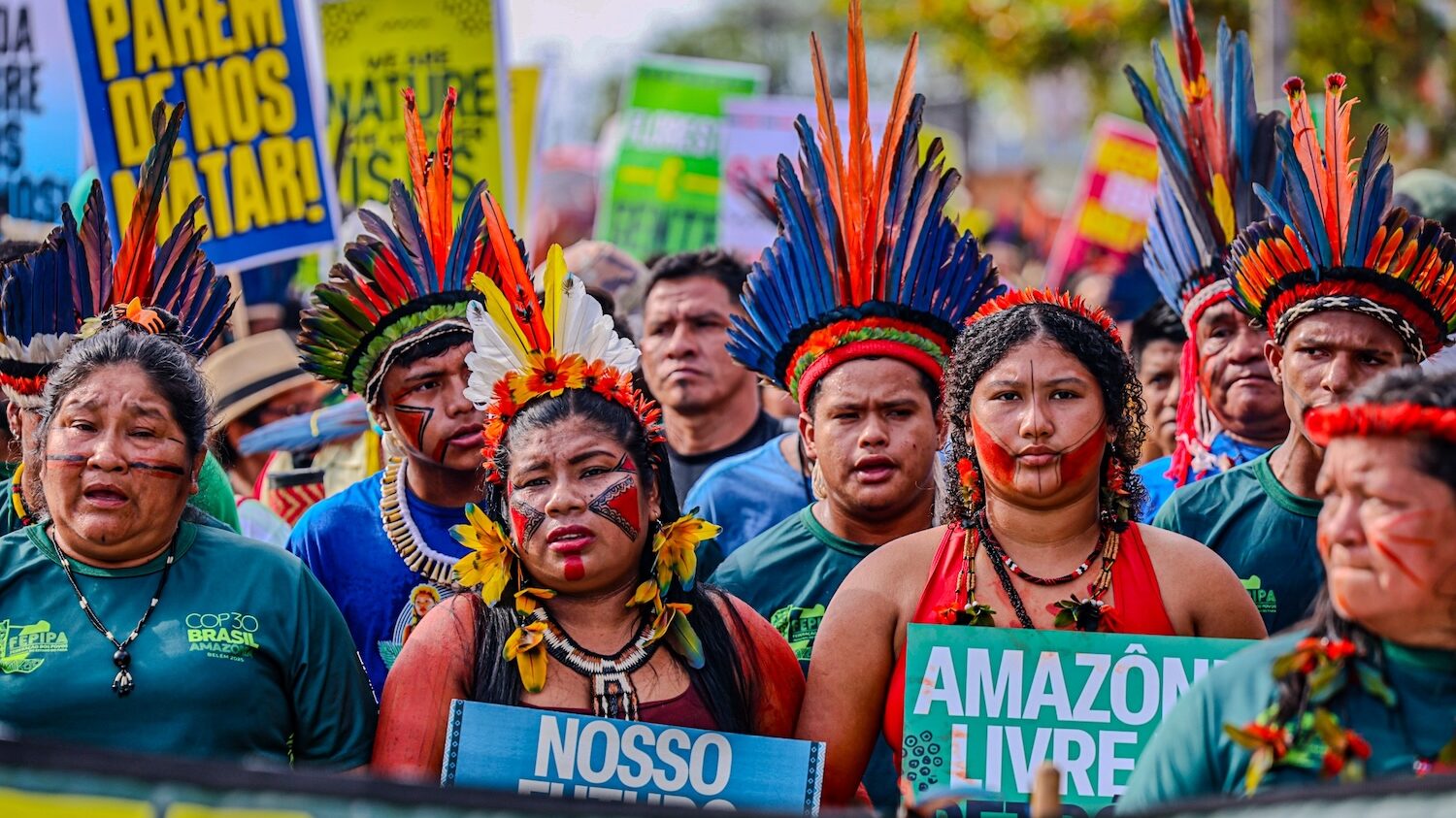
Progress at COP30 Is Not Enough Without Indigenous Power at the Center
What COP30 made clear is that the Indigenous movement has amassed political influence like never before. More than 900 Indigenous delegates from around the world participated in official debates, a record high. Advances in Indigenous land tenure and renewed financial pledges that aim to channel resources directly to Indigenous peoples and local communities, are all signs that progress is being made.
But celebrating this progress does not mean settling for it. Many Indigenous peoples’ participation remains on the fringes, stretches of Indigenous lands across the Amazon and beyond remain without formal recognition, leaving communities vulnerable to industrial expansion, and the very fossil fuel projects that world leaders again failed to move away from.
Beyond the walls of COP, world leaders must finally act on the truth that Indigenous land defenders hold a huge part of the answers we seek. Humanity is not winning the fight against the climate crisis, and one of our greatest opportunities to turn the tide lies in delivering the full resources, authority, and political space Indigenous communities need to protect our planet’s last remaining ecosystems that sustain all life.
Sources:
- Earth Insight, Indigenous Peoples’ Territories and Local Communities on the Frontlines, November, 2025. ↩︎
- DW, Mutirao: Brazil’s Indigenous answer to the climate crisis, November, 2025. ↩︎
- DW, Mutirao: Brazil’s Indigenous answer to the climate crisis, November, 2025. ↩︎


